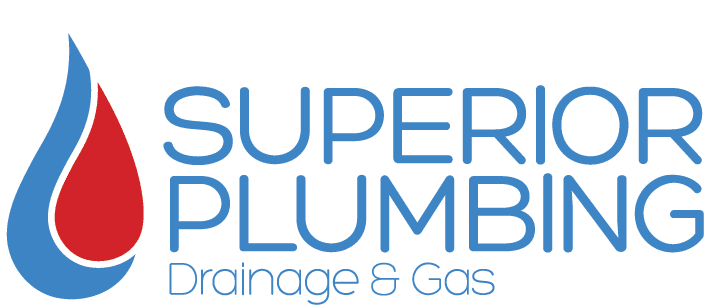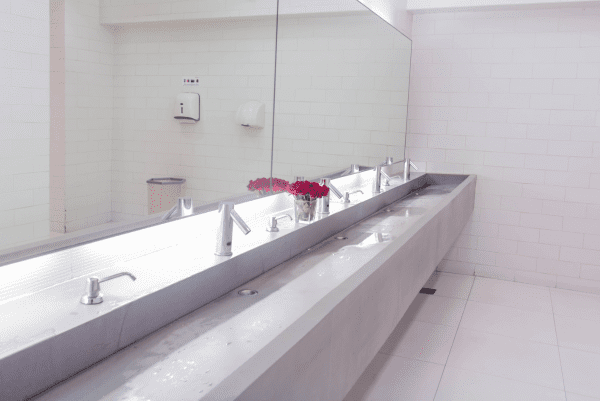Commercial restrooms are high-traffic areas that face unique plumbing challenges due to constant use and diverse user behaviours. Superior Plumbing & Gas is here to help you maintain a properly functioning plumbing system to ensure a positive experience for customers, employees, and visitors.
Restrooms: Prone to Plumbing Problems
Several key reasons contribute to the increased vulnerability of commercial restroom plumbing:
- High Traffic Volume: Commercial restrooms experience a significantly higher user volume than their residential counterparts. The sheer number of people using the facilities increases the likelihood of wear and tear on plumbing fixtures, pipes, and other components.
- Frequent Use: Commercial restrooms are in use throughout the day, often without significant downtime for maintenance. The continuous flushing of toilets, running of faucets, and use of other plumbing fixtures can lead to accelerated wear.
- Diverse User Behaviours: Commercial restrooms serve individuals with various habits and behaviours. Some users may misuse or abuse the facilities. This can lead to clogs, overflows, or damage.
- Limited Maintenance Windows: Due to the operational demands of businesses and public spaces, there may be limited time for thorough maintenance and inspections. Neglected or delayed maintenance can lead to more significant issues over time.
- Variety of Fixtures: Commercial restrooms often feature a range of plumbing fixtures, including toilets, sinks, urinals, and hand dryers. This complexity of the overall plumbing system increases the likelihood of malfunctions.
- Ageing Infrastructure: Commercial buildings may often have older plumbing systems. Ageing pipes and fixtures are more susceptible to corrosion, leaks, and other issues.
Now we know the reasons behind the problems, let’s look deeper at the challenges they create and how to tackle them.
Challenges and Solutions
Maintaining a well-functioning plumbing system in commercial restrooms is essential for ensuring a positive experience for users and avoiding costly repairs.
Clogged Drains
Clogged drains are a pervasive issue in commercial restrooms. Clogging often stems from the accumulation of debris, soap scum, and foreign objects within the plumbing system. The consequences range from slow-draining sinks to complete blockages that can disrupt restroom functionality. Possible solutions are:
- Professional Drain Cleaning: Implementing a routine schedule for professional drain cleaning is essential. Plumbing professionals like Superior Plumbing & Gas can employ specialised tools and techniques to clear out debris, ensuring a smooth flow of water through the drains.
- Drain Strainers: Installing drain strainers is a practical and cost-effective measure to reduce the likelihood of clogs. These simple devices act as filters, trapping hair, soap scum, and other debris before they enter the drain. Choose drain strainers with fine mesh to capture even small particles effectively.
- User Education: Common culprits for clogged drains include paper towels, feminine hygiene products, and excessive toilet paper. Educating restroom users about proper disposal practices via clear signage is a proactive strategy to combat clogged drains.
Running Toilets
Running toilets are often caused by general wear and tear and contribute to significant water wastage. Addressing running toilets requires a proactive approach to maintenance. Measures that can contribute to better toilet efficiency include:
- Fixing the Flapper: The flapper is a rubber component that seals the flush valve. If it doesn’t create a proper seal, water will continuously leak into the bowl, causing the toilet to run. Regularly inspect the flapper for wear and tear and replace it if necessary. Ensure that it forms a tight seal after each flush.
- Inspecting Imbalanced Floats: The float regulates the water level in the tank. If it’s imbalanced or damaged, it can result in a continuous water flow, leading to a running toilet. Check the float’s position and adjust it as needed. If the float is damaged, consider replacing it with a new one.
- Finding Fill Valve Issues: Problems with the fill valve can also cause a running toilet. Issues may include a faulty valve, sediment buildup, or a misadjusted water level. Inspect the fill valve for proper functioning. Clean or replace the valve if there is sediment buildup, and adjust the water level to the recommended mark.
- Upgrading to Water-Efficient Features: Dual-flush toilets offer users the option of a low-volume flush for liquid waste and a higher-volume flush for solid waste. This flexibility helps conserve water by matching flush volume to actual needs. Sensor-activated flush systems eliminate the need for physical contact, promoting hygiene and reducing the risk of germ transmission. These systems are also designed to use water more efficiently.
Leaky Faucets
Leaky faucets are a common issue in commercial restrooms that can lead to water wastage, increased utility costs, and potential damage to fixtures and surrounding areas. Consider these factors for functioning faucets:
- Worn-Out Washers: Faucet leaks often result from worn-out washers, which are rubber or silicone components that create a seal between the faucet and the handle. Periodically check and replace worn washers to maintain a watertight seal.
- Damaged O-rings: O-rings are another common source of leaks around the base of the faucet spout or in the handles. During regular inspections, examine O-rings for signs of damage or deterioration. Replace them as needed to maintain a proper seal and prevent water leakage.
- Faulty Cartridges: Cartridges control the flow of water in the faucet. If damaged or worn, they can cause leaks or irregular water flow. Check cartridges for signs of wear or damage and replace them if necessary.
- Upgrading to Sensor-Activated or Touchless Faucets: These modern fixtures offer several benefits beyond water conservation. Sensor-activated faucets only release water when motion is detected, eliminating the possibility of leaks caused by users not fully closing traditional handles. Users also don’t need to touch the handles, promoting a more sanitary restroom environment.
Pipe Leaks
Leaks can significantly damage the restroom infrastructure and surrounding areas. Water leakage can weaken the structural integrity of walls, floors, and ceilings. It can also damage fixtures, such as sinks and toilets, leading to costly repairs or replacements. Try the following to avoid such costs:
- Frequent Inspection: Establish a regular inspection schedule, taking into account the type of facility and considering seasonal variations that may affect plumbing. Adjust inspection frequency accordingly, with more frequent checks during extreme weather, such as freezing temperatures.
- Comprehensive Examination: Ensure that inspections cover all plumbing components, including pipes, joints, faucets, valves, water heaters, and drainage systems. Pay attention to both visible and concealed elements, such as pipes within walls or beneath flooring.
- Identifying Potential Issues: Look for signs of wear and tear, corrosion, rust, or mineral deposits on pipes and fixtures. Actively search for any visible leaks or drips. Even minor leaks can lead to water damage over time. Monitor water quality for any changes in colour, odour, or taste. These changes can indicate issues with the plumbing system or water supply.
- Taking Preventive Measures: Periodically flush and clean the plumbing system to remove sediment, mineral buildup, and other debris. Lubricate moving parts such as valves and tighten loose connections during inspections. Identify and replace worn-out or damaged parts before they lead to system failures. Parts include components like seals, gaskets, and washers.
- Leak Detection Devices: Consider installing leak detection devices as part of your restroom’s infrastructure. These devices can quickly identify leaks and send alerts to maintenance staff. Early detection allows for immediate action, reducing the risk of extensive damage.
Low Water Pressure
Low water pressure can be frustrating in commercial restrooms, affecting user satisfaction. You can combat this by taking the following steps:
Regular Flushing to Remove Mineral Buildup: Over time, mineral deposits, such as calcium and magnesium, can accumulate in pipes, restricting the flow of water and causing a decrease in pressure. Establish a routine flushing schedule to remove mineral buildup from pipes.
Prompt Addressing of Pressure Regulator Issues: Pressure regulators are devices that control the water pressure within a plumbing system. If they malfunction or become faulty, it can result in inconsistent or low water pressure. Regularly perform diagnostic checks and repair or replace faulty regulators to restore optimal water pressure.
System Design Improvements or Upgrades: In some cases, low water pressure may be attributed to the overall design of the plumbing system. A plumbing expert like those at Superior Plumbing & Gas can identify weak points in the system design. Inspections may involve assessing the size and layout of pipes, identifying bottlenecks, or addressing issues with the water supply infrastructure.
Upgrading Fixture Selections: Consider upgrading to water-efficient fixtures like low-flow faucets and toilets. These fixtures are designed to maintain adequate pressure while conserving water, improving water efficiency and user satisfaction.
Maintaining Superior Plumbing Standards
Professional plumbers bring a combination of expertise, experience, and resources to address the challenges of commercial restrooms effectively. Commercial establishments, especially those with public restrooms, can’t afford extended downtime due to plumbing issues. Professional plumbers prioritise timely repairs to minimise disruptions to business operations.
Superior Plumbing & Gas can navigate complex systems and provide efficient solutions to maintain the functionality and hygiene of your commercial infrastructure. We will provide rapid response and quick resolutions to prevent further damage. It’s time to get proactive and employ preventative maintenance for long-term satisfaction and savings. So, get in touch today for a quote!


